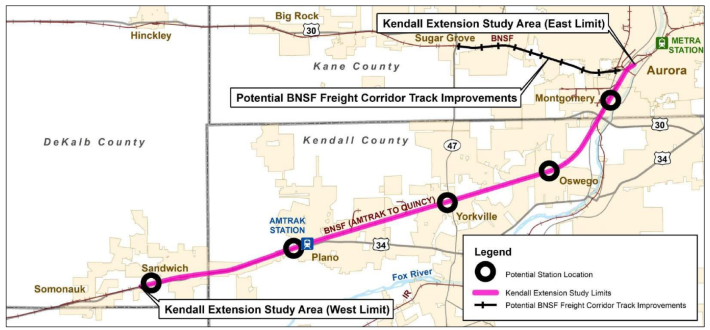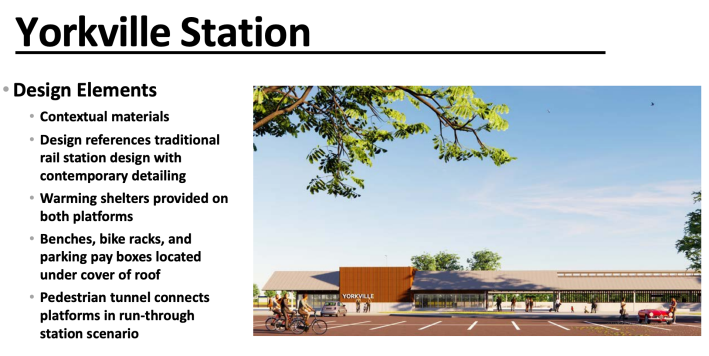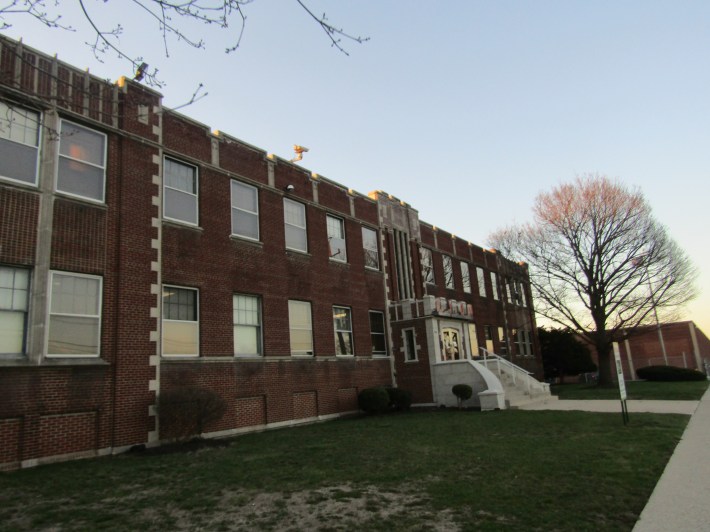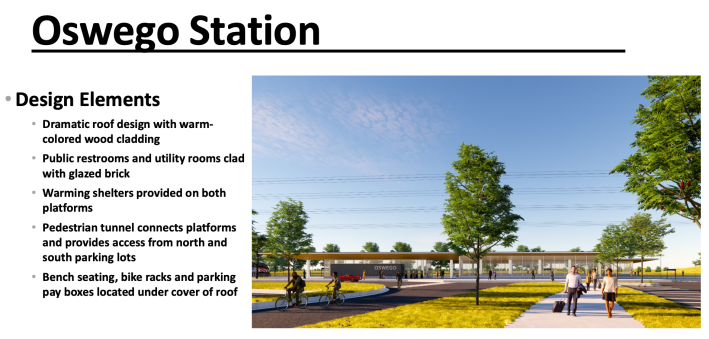The potential BNSF Metra Line extension to Kendall County, which local mayors have lobbied for over the past three decades, is still nowhere near a sure thing. But at least now we have some sense of how much it would cost.
The extension would serve the southwest exurbs of Montgomery, Oswego and Yorkville, and potentially extend further west to the cities of Plano and Sandwich. It would follow the existing BNSF Railway route, which currently terminates in Aurora, but stations and rail yards would have to be built from scratch. While Plano already has Amtrak service, the other municipalities don’t have any kind fixed route connections to the rest of Chicagoland, not even bus service.

Depending on how far the extension goes and how many trips a week there would be, it could take anywhere between $400 million and $700 million to get the service up and running, and anywhere from $6 million and $14 million a year to keep it going. Local officials argued that the extension would help the mostly rural region grow and develop, and make it easier for residents to get to the Loop. But for Metra, the issue is that, because Kendall County isn’t part of the Regional Transportation Authority's six-county region, it doesn't contribute tax dollars to Chicagoland's transit funding pot. The county would either have to join the RTA or find some other way to come up with the money to build the extension and keep the trains running.
In May 2019, Metra contracted the Chicago-based planning firm Alfred Benesch & Company to do a study that would give the county and the municipalities an idea of exactly how much money they would have to come up with for the extension. Residents got to see the results during a March 10 online community meeting. It is now up to the Kendall County and the municipalities to decide how to proceed.
Background
BNSF Railway owns the entire rail line and operates commuter service under contract with Metra. While Amtrak's state-funded Carl Sandburg and Illinois Zephyr routes previously made two round trips that served Plano, pandemic-related budget cuts reduced the schedules to one round trip.
The village of Montgomery is partly located in Kane County, which is already part of the RTA region, but the rest of the town is located in Kendall County. Oswego, Yorkville and Plano are in Kendall, while Sandwich is split between Kendall, DeKalb, and LaSalle counties. While the Metra Union Pacific North line’s service to Kenosha, Wisconsin, goes outside of the RTA district, Metra keeps it going because using the existing Kenosha train yard is less expensive than building a new one in Lake County.
Metra spokesperson Michael Gills previously told me that hundreds of riders from those towns were already driving to Aurora to catch the train. But in a more recent interview, he reiterated that Metra hasn't endorsed any line extension proposals, preferring to focus on improving existing service. The only reason why the study happened was because it was funded through earmarked federal funds.
Station Sites
All of the proposed stations have certain common features: two platforms, with a larger station house on the inbound side and a smaller warming shelter on the outbound side; bike racks; at least one large parking lot; and underground pedestrian tunnels to link the two platforms. The Yorkville and Plano station plans come with the caveat that, if one of them would be the terminal, a rail yard to store the trains overnight would need to be built further west.
All the stations have large parking lots, which make some sense for any station in Oswego and Yorkville, since the existing tracks are outside pedestrian-friendly downtowns. But in Sandwich and Montgomery, the tracks run through or near more walkable downtowns, which likely makes large amounts of parking overkill. A more productive use of the land might be creating transit-friendly housing and retail.

While Plano’s existing Amtrak station is downtown, the study calls for a brand-new station about 1.2 miles further west, directly east of Little Rock Road, with a parking lot on the north side of the tracks. Plano mayor Bob Hauser said that wasn’t the city’s idea. “We wanted to utilize our existing site, but it wasn’t feasible with the Metra requirements,” he said.
Gillis said the study called for a new station precisely because there isn’t room for large parking lots. Again, that's kind of a chicken-and-egg situation: If your station is located near where people live and work, tons of parking isn't needed.
Gillis added that another factor was that BNSF Railway didn’t want cross streets to break up the platforms, and closing the crossings “would require the closing of at least one important street in downtown Plano.”

Meanwhile, the Montgomery station would be located at the village’s preferred site, the former Lyon Metal manufacturing complex in the Kane County portion of Montgomery. The parking lot would replace the industrial buildings east of the tracks, while preserving the main Lyon Metal building. Since, unlike the other proposed stations, the stop would be located on an embankment, there would be stairs and wheelchair ramps leading to the platforms. The station would have a bus turnaround on the inbound side, but there are no firm plans about which buses would be allowed to use it. The closest Pace bus route to the Montgomery station site is Route 542, which links the Aurora Transportation Center and destinations on the west side of Aurora.
The Oswego station would be constructed west of Orchard Road, where the village already built a parking lots and a park-n-ride on the south side of the tracks. The plans call for an additional parking lot to the north of the tracks.

The Yorkville station would be located directly north of the Wrigley chewing gum plant, with a parking lot located south of the tracks.
Finally, the Sandwich station would be located on vacant land west of downtown, in the DeKalb County portion of the city between Ghetty Road and Fairwinds Crossing. Two new tracks would be built north of the main line and lead to the rail yard on the other side of Ghetty Road. The only platform would be located north of the tracks, with the parking lot located right behind it, so it wouldn’t need a pedestrian tunnel.
Costs
The study looked at the cost of running two round trips (like the pre-pandemic Carl Sandburg and llinois Zephyr service), four round trips, and six round trips, and what the costs would be for running the service as far as Yorkville versus a Plano or Sandwich terminal. The study looked at the costs of building the stations and the rail yard, buying the train sets and making other improvements, as well as the costs of keeping it running.
The Rebuild Illinois capital bill allocated $100 million to help cover the infrastructure costs. But the study estimates that even the cheapest option, two round trips to Yorkville, would require $400 million in capital costs and $6 million in regular operational costs. The most expensive option, six round trips to Sandwich, would have around $675-$700 million in capital costs and $14 million a year in regular service costs.
The study also looked at projected weekday ridership by 2050 based on different levels of population growth and pre-pandemic ridership patterns. It found that, once one subtracts riders who drove to Aurora or other existing Metra stations to catch a train, the extension to Yorkville would attract between 1,401-2,908 new riders, while the extension to Plano would attract between 1,501-3,057 new riders, and the extension to Sandwich would attract between 1,643-3,167 new riders. The ridership projections indicate that Plano and Sandwich would get fewer new riders than for the other three.
The consultants suggested that federal grants would be best way to cover most of the capital costs, mentioning the Federal Transit Administration’s New Starts program and the U.S. Department of Transportation’s Better Utilizing Investments to Leverage Development (BUILD) grants as examples. However, they also warned that the municipalities would need to come up with a local match, and that, given the federal cost-benefits analysis process, the Yorkville extension has the best chance of getting the funding. President Joe Biden's $2 trillion infrastructure plan, announced last Wednesday, which includes a relatively generous $85 billion for transit, makes the possibility of federal help much more likely.
During the meeting, officials discussed sources of operational funding. Any alteration of the RTA service area would require a new state legislation. Alternatively, townships, municipalities or counties can form a Local Mass Transit District to fund transit service. However, as noted during the presentation, it would have a smaller tax base than the RTA, since it would only be able to levy a property tax that would have to be approved by a referendum.
More information about the Kendall County Metra extension proposal is available here.




